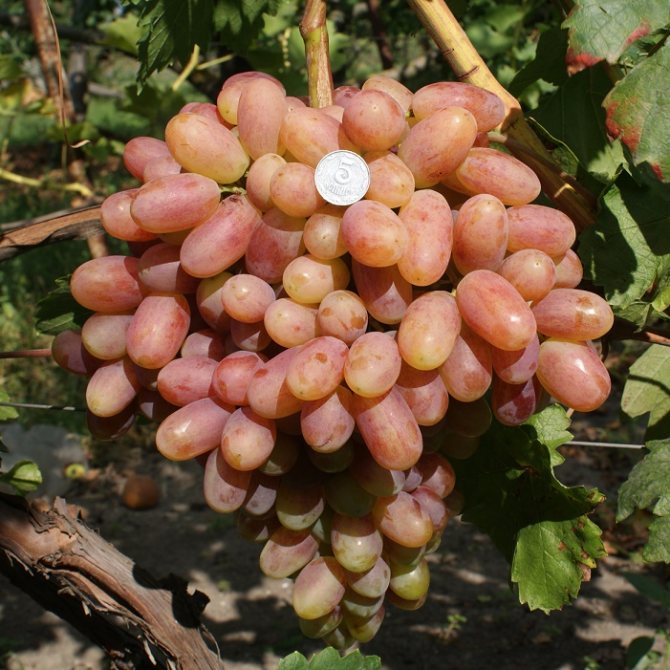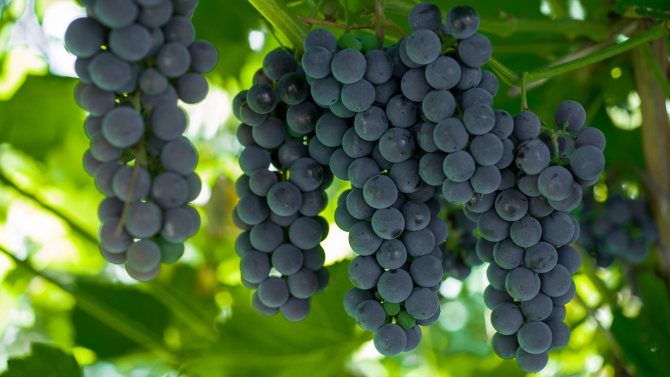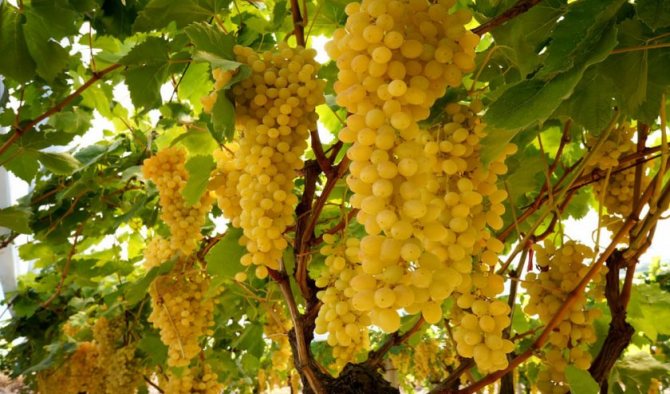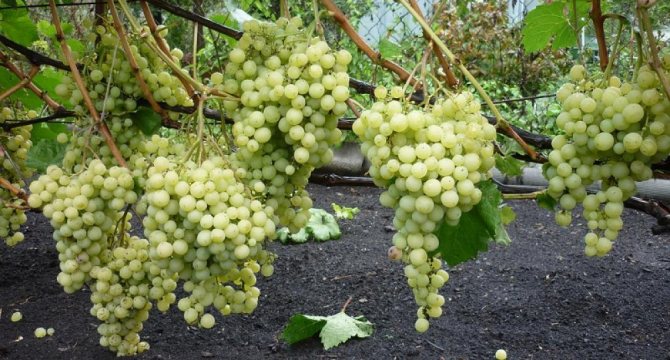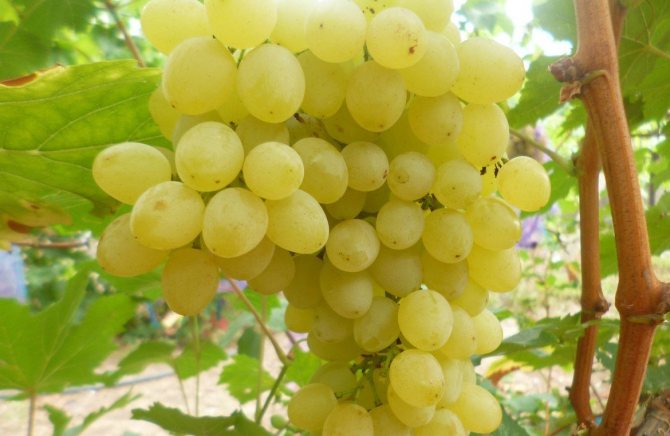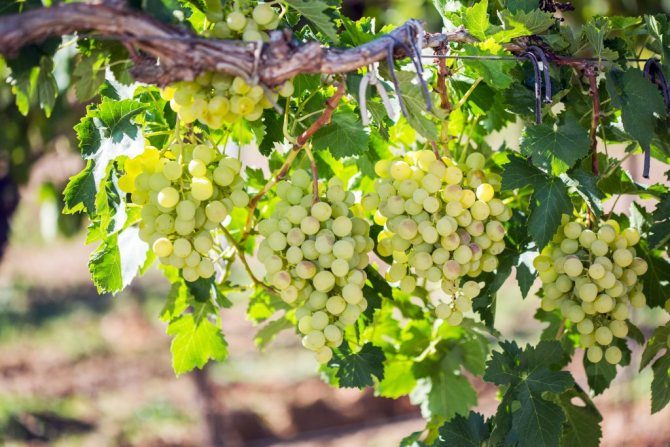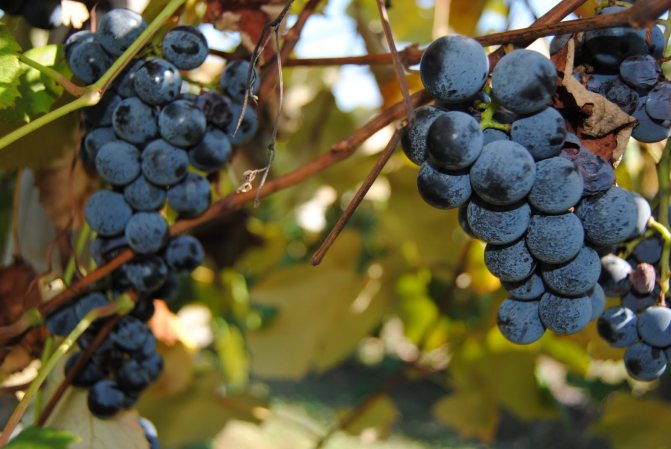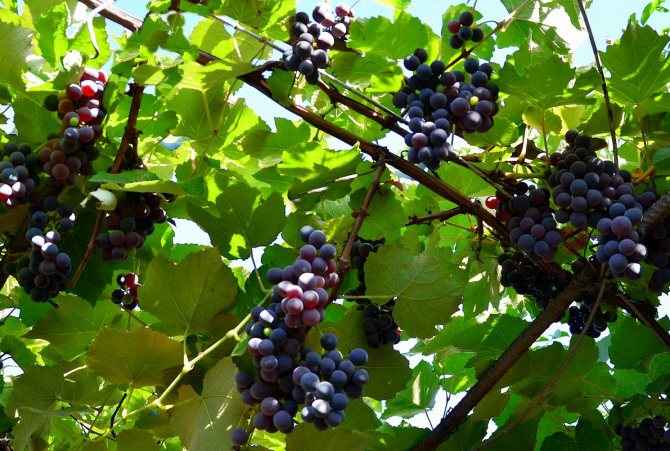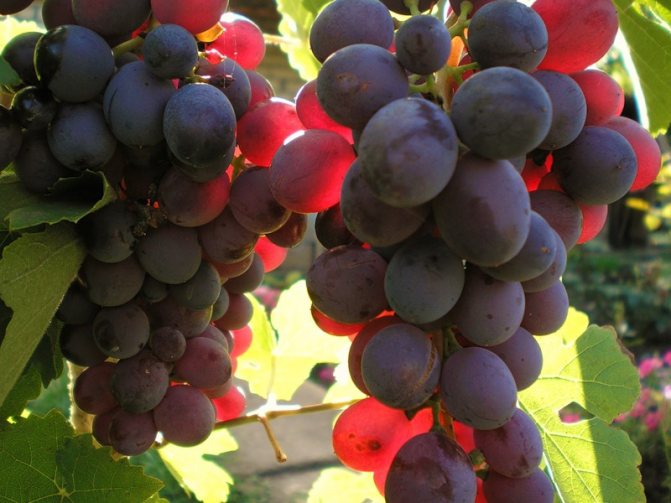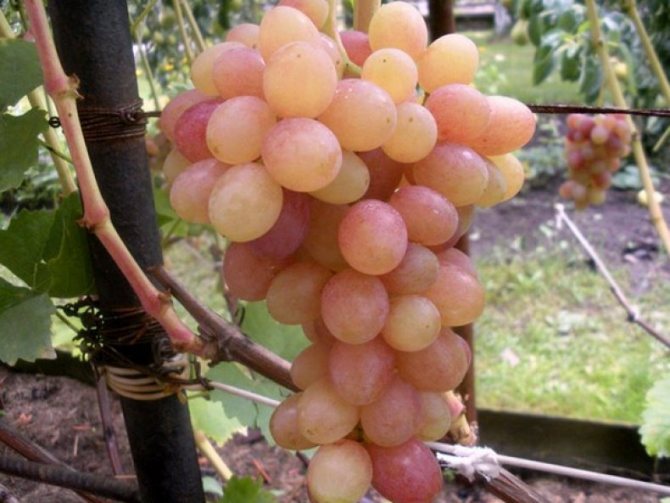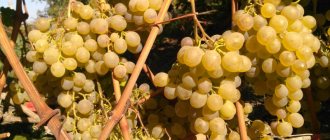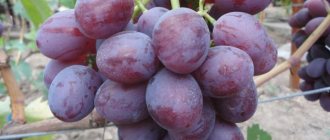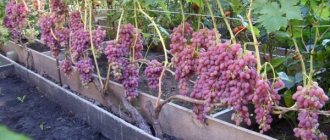Grapes are one of the most thermophilic and capricious crops. In the south of Russia, any variety is grown without shelter; in other areas, such experiments most often end in partial or complete freezing of the vine in winter. Gardeners in the middle lane have to face a lot of problems and make great efforts to get a good harvest. Check out the list of the best non-sheltering grape varieties for the Moscow region, learn how to care for a crop in difficult climatic conditions.
Is it possible to grow grapes in the Moscow region
Contrary to popular belief, grapes are not that soft. It is quite successfully grown by amateur gardeners of Siberia, the Urals, the Central Non-Black Earth Region and, of course, the Moscow Region. There are many resistant grape varieties, undemanding to heat, withstanding low negative temperatures, and in terms of yield and quality of berries that are not inferior to the best European varieties.
In the Moscow region, grapes are one of the most profitable crops. It gives high and stable yields, up to 6-10 kg per bush, and sometimes up to 25-27 kg. This plant is early ripening, bears fruit in the second or third year of planting, and on any soil, it tolerates a high level of groundwater, and there are quite a lot of such sites in the Moscow region. It is easier to protect it from spring frosts than pome and stone fruit crops.
Growing grapes in the Moscow region is even easier than in the zone of industrial viticulture:
- Due to the absence of viral diseases and pests of grapes in cool climatic conditions, there is no need for multiple treatments of bushes with chemicals.
- The methods of "dry" shelter developed by amateur gardeners for the winter are less laborious than those used in the south of the country.
- Thick snow cover in the Moscow region provides additional protection in winter.
The taste of the grapes grown in the Moscow region is in no way inferior to the southern one.
Agat Donskoy
Agat Donskoy is considered one of the best non-covering grape varieties with unique characteristics. It was bred by selection based on the species Dolores, Zarya Severa and Russian Early.
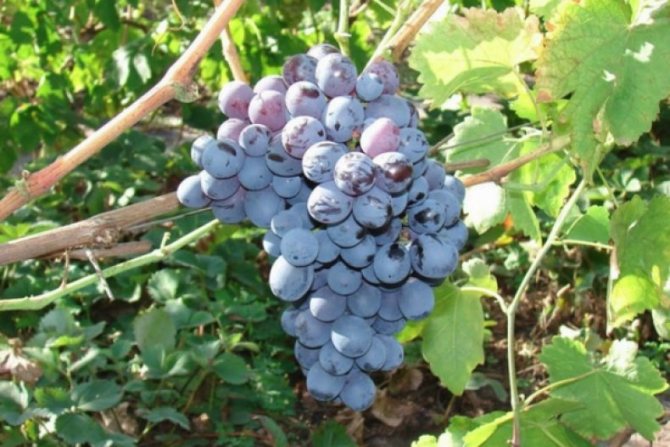
The shrubs are very strong, reaching a height of 1.7 m, they are characterized by abundant fruiting. The berries are large, dark blue, weighing about 4-5 g, from which clusters of 600 g are formed.
Caring for such plants is not burdensome, the variety is bisexual, the cuttings take root perfectly, the frost resistance threshold is up to minus 26 degrees. It is worth adding to this also excellent immunity to both garden pests and fungal infections.
Verified grape varieties for the Moscow region with photos and descriptions
The climatic conditions of the Moscow region with a limited amount of positive temperatures allow growing in open ground only varieties of early and very early ripening.
They should be high-yielding, produce tasty, but not too large berries, and the vine should ripen simultaneously with the harvest and be ahead of it. Pollination of flowers and ripening of berries should take place despite rainy weather.
For an unheated greenhouse
Grape varieties for open ground in the Moscow region can also be grown in an unheated greenhouse. There they give a more weighty and high-quality harvest, the sugar content of the berries increases by 20-50% and ripens 2-3 weeks earlier.
Such varieties are most widespread in unheated greenhouses of the Moscow region.
Tomaysky
Tomaysky - very early, medium-sized. The bunches are large (350–600 g), the berries are oval, red-violet, weighing 5–6 g, the largest up to 9 g. The pulp is fleshy, juicy, with a nutmeg aroma. Shoots ripen well. Withstands frosts up to 23 ° C.
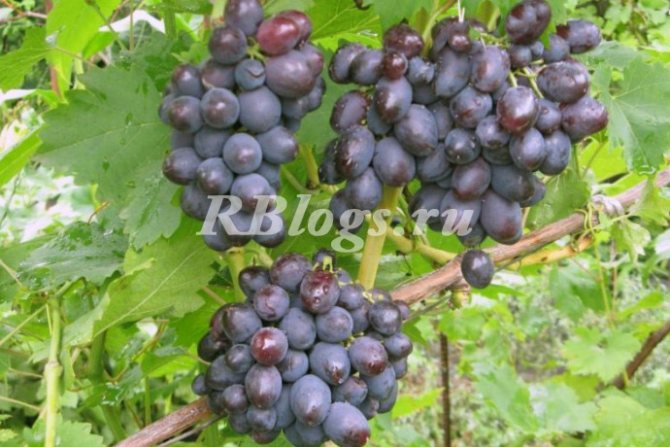

Tomaysky grapes
Arcadia
Arcadia is vigorous, high-yielding. The bunches are large (500–700 g), with good care up to 2 kg. The berries are very large, weighing 7-10 g, heart-shaped, white. The pulp is fleshy, with a good harmonious taste. Withstands frosts up to 23 ° C. After severe damage, for example, by mice, it recovers well. Shoots ripen 60–70%. The main advantages of the variety are good presentation of berries and good transportability.


Arcadia grapes
Superearly seedless
Superearly seedless - medium-sized, high-yielding, shoots ripen satisfactorily. The clusters are medium and large (300–400 g), conical and winged, loose. The berries are medium, slightly oval, white, seedless. Sugar content 14-16%. Used fresh and for drying. When overexposed on the bushes, their sugar content increases, and the berries themselves wither.
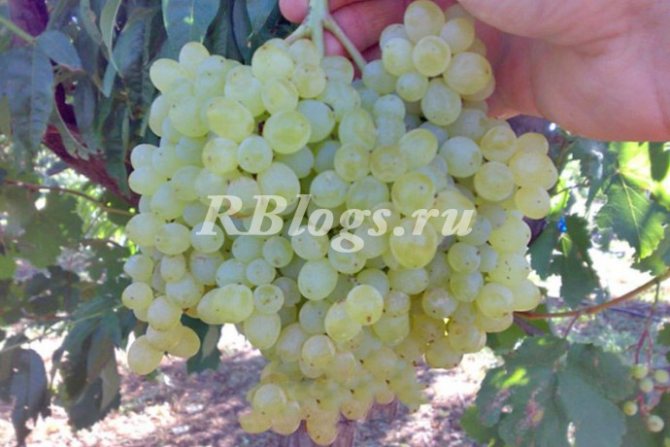

Grape Superearly seedless
Kishmish Mirage
Kishmish Mirage - vigorous, fruitful, seedless, disease-resistant. The bunch is large (300-400 g). Berries are medium, weighing 2–2.5 g, white, medium density, ripen at the end of August, high-sugar (19–20%) with low acidity.


Grapes Kishmish Mirage
Tighin
Tighin is medium-sized, early maturing, high-yielding, disease-resistant, withstands frosts up to 25 ° C. The bunches are medium and large (400-700 g), loose, hang on the bushes for a long time, without losing quality. The berries are round or oval, large (5-6 g), white. The pulp is fleshy, juicy, with a strong nutmeg aroma.
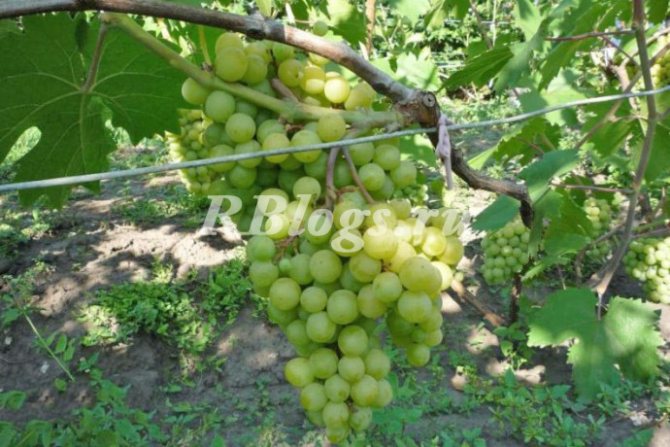

Tighin grape
Thor Heyerdahl
Thor Heyerdahl - vigorous, high-yielding, shoots and vines ripen well. The clusters are very large (700–800 g), branched, loose. The berries are white, oval, very large (10–12 g). The pulp is crispy. The taste is simple and pleasant. The berries are transportable, suitable for storage. The variety needs artificial pollination.


Grape Thor Heyerdahl
Codryanka
Codryanka - vigorous, high-yielding, very early ripening, withstands frosts up to 23 ° C. The vine ripens well. The clusters are large (400–500 g), of moderate density. The berries are large (6–7 g), oblong, dark purple, of excellent taste. Transportable.
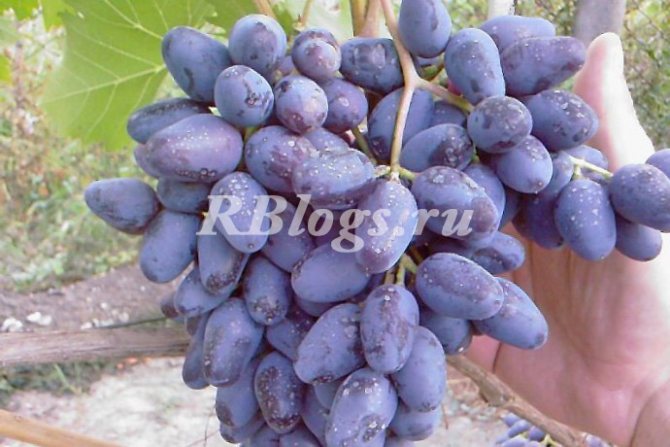

Codryanka grapes
For open ground
The following varieties are most suitable for open ground: Aleshenkin, Pamyat Domkovskaya, Agat Donskoy, Cosmonaut, Summer Muscat, Early Violet, Special, Muscat Pleven, GBS-1 Seedian and Rusven.
Aleshenkin
Aleshenkin - very early ripening, vigorous, high-yielding. Shoots ripen by 70–80% even in unfavorable years. The bunch is large, conical, sometimes branched, the average weight is 600 g. The berries are medium and large in size (3.5 g), slightly oval, amber in color, good taste. Ripen in early September.
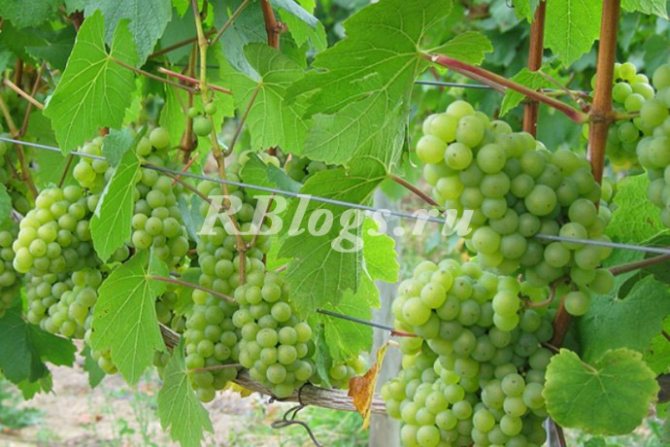

Aleshenkin grapes
Memory of Domkovskaya
Memory of Domkovskaya - a very early ripening period, vigorous, fruitful. Shoots ripen well. The bunch is large, dense, winged, the average weight is 350 g, the largest - up to 600 g. The berry is medium, black, without seeds. Sugar content 18%. The juice is maroon color. Ripens in early September. Differs in high frost resistance. By the degree of vine ripening, high yield and quality, it is one of the best varieties for the Moscow region.
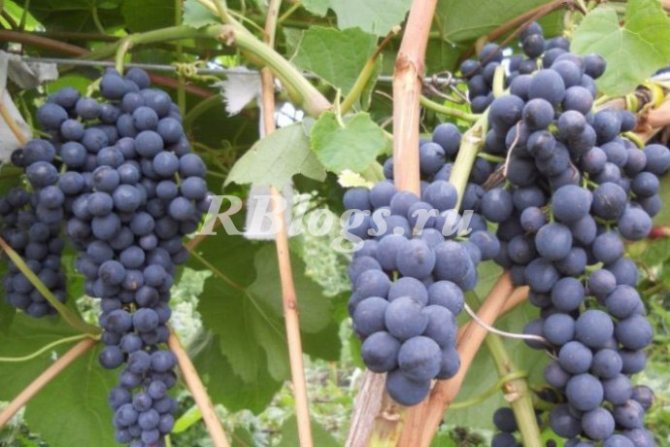

Grapes Memory of Domkovskaya
Agat Donskoy
Agate Donskoy - very early, vigorous, high-yielding. The vine ripens well. The bunch is large (average weight 350–400 g), conical, loose. Berries are black, large (4 g), round, pleasant taste. Suitable for storage and transportation. If the bunches are hung in a cool, well-ventilated area, the berries wither and remain until February.
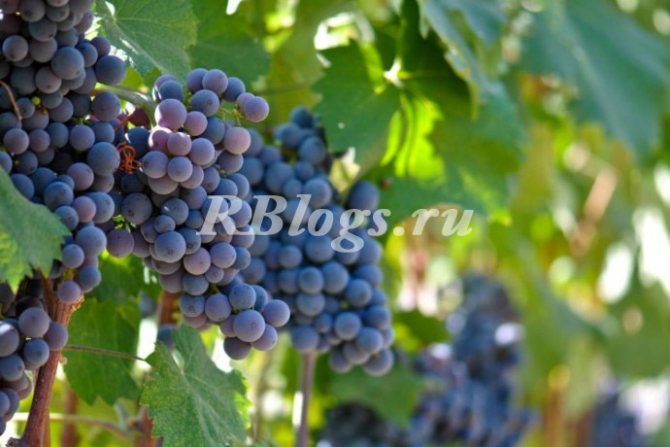

Grape Agate Donskoy
Cosmonaut
Astronaut - early ripening, vigorous, high-yielding. The clusters are small (165 g), conical, of medium density. The berries are large, black, round and oval, with a good taste. The variety is resistant to gray mold.
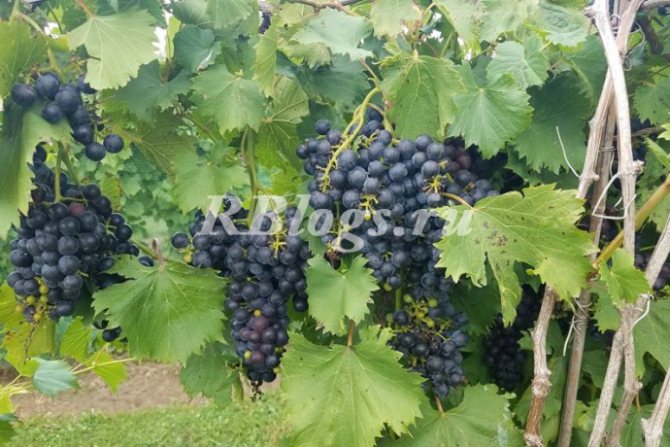

Grape Astronaut
Summer Muscat
Summer nutmeg - early ripening, vigorous, average yield. The berries are very large, oblong-ovate, amber-white. The pulp is fleshy, juicy, with a nutmeg aroma.
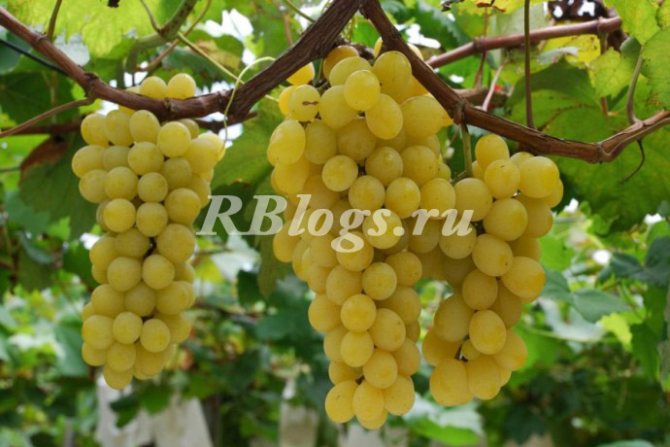

Summer Muscat grapes
Early purple
Early purple - medium-sized, high-yielding. The vine ripens satisfactorily. Bunches of medium size (150–180 g), conical, loose. The berries are medium, round, dark purple, with a pronounced nutmeg aroma, sugar content 18–20%, ripen in early September.


Grape Violet early
Special
Special - early, vigorous, fruitful. The vine ripens satisfactorily. The clusters are medium and large, conical, medium density, loose. The berries are round, white, of good taste, they remain on the bushes for a long time, without decay.
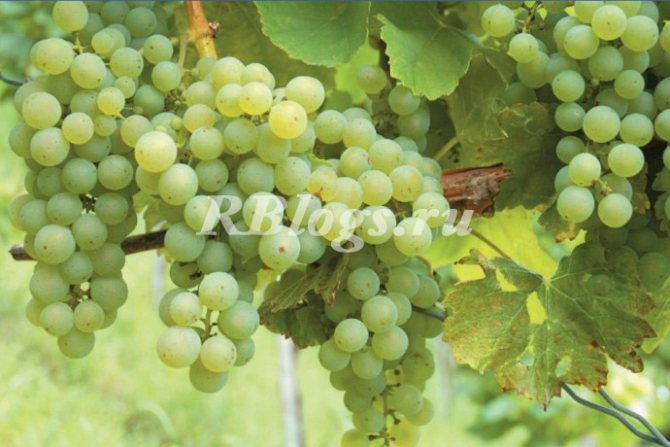

Grape Special
Pleven nutmeg
Muscat Pleven - early, tall, high-yielding. The bunches are large, the berries are white, nutmeg, with a high sugar content - up to 22%, they stay on the bushes for a long time.
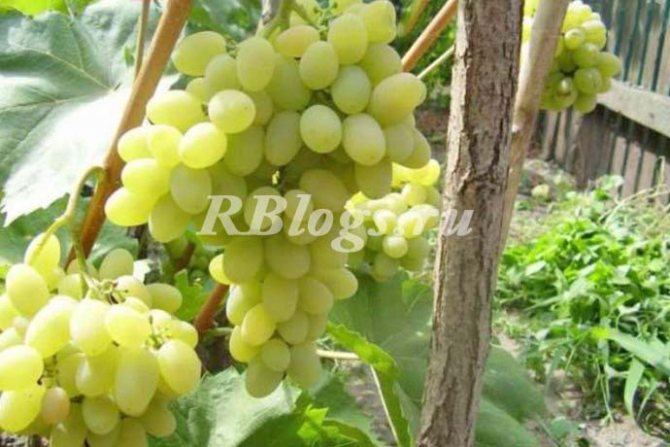

Pleven Muscat grape
Seedling GBS-1
Seedling GBS-1 - widespread in the Moscow region, very early ripening, fruitful. The bunch is medium and large, of medium density. The berries are medium, white, round, pleasant to the taste, without aroma. Sugar content 15-16%, low acidity. The berries do not crack and are not affected by gray rot.
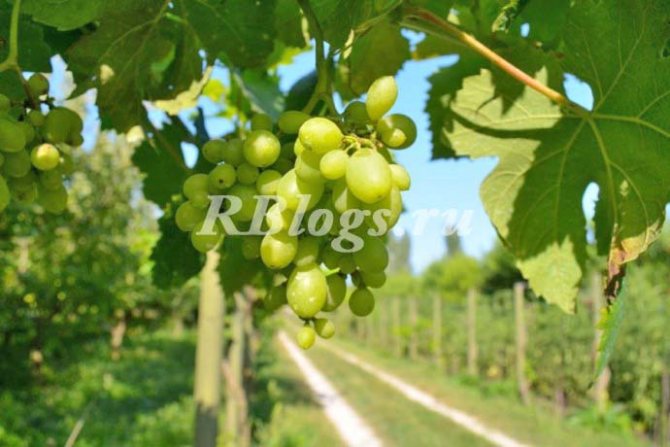

Grape Seedling GBS-1
Rusven
Rusven is vigorous, high-yielding. Bunches are cylindrical, large (500-700 g), medium density. The berries are large (6–7 g), white, pinkish in the sun. The pulp is fleshy, juicy, with a slight nutmeg aroma. Shoots ripen well.


Rusven grapes
All of these varieties are resistant to diseases and low temperatures - the vine can withstand frosts up to 25-26 ° C. Nevertheless, the bushes require shelter for the winter. And besides, in order to speed up the growing season and protect the plants from spring frosts, they, from the first days of May to June 10, are kept under a film on arcs.
Non-covering varieties
In the Moscow region, varieties for open ground are widespread, bred specifically for the extreme conditions of the Non-Black Earth Region. They are called undisguised. For the winter, it is enough to lower the vines from the trellis and cover with rags. These include:
- Moscow sustainable;
- Moscow dacha;
- Moscow early;
- Gift from TSKHA;
- Early TLCA and others.
However, in terms of the quality of berries and some other characteristics, these varieties are inferior to those listed above.
Winegrowers identify the most promising non-covering varieties for the Moscow region:
Buffalo is of American origin and can withstand temperatures up to 30 ° C. The bushes are vigorous. The clusters are medium, round-conical in shape. The berries are dark blue, large, up to 5 g, with a very sweet pulp. Ripen in early September. The variety is high-yielding, on large formations (in the southern regions) it gives up to 100 kg per bush. Resistant to viral diseases. Does not require chemical treatments.
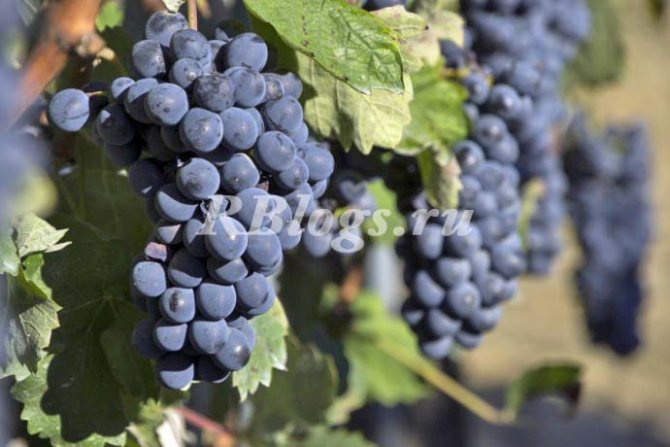

Buffalo grapes
Lucille is of American descent. Withstands frosts up to 35 ° C. The bushes are vigorous. The bunches are medium (150-200 g). The berries are medium and large (3-5 g), pink in color. The pulp is juicy, very sweet, with a strong distinctive floral aroma. The berries are good for processing. The yield is very high.


Lucille grape
Kiev violet - tall, disease resistant. Withstands frosts up to 32 ° C. The bunches are medium and large. Berries weighing 3.5 g, dark red, with strawberry flavor. The sugar content is high. The yield is very high - 3-4 clusters on the shoots. Gives up to 80 kg per bush per season.
Sadko is a complex European-Amur hybrid. Withstands frosts up to 26-27 ° C. The bushes are vigorous. The bunches are large (800-900 g), the berries are white with a pink tint, round, large (5-6 g).The pulp is fleshy, juicy, harmonious taste. Recommended for northern regions.
Romulus is a raisin variety from the USA. The bushes are medium-sized. The clusters are medium and large (200–500 g), loose. The berries are medium, round, green-golden. The pulp is fleshy, juicy, pineapple flavor. The yield is high - 10-12 kg per bush. Shoots ripen well. Disease resistance is high. It accumulates sugar well and gives high quality dried products - raisins. Withstands frosts up to 27 ° C.
Kishmish Radiant
Radiant kishmish is one of the most popular winter-hardy non-sheltering varieties, which is successfully cultivated in the Moscow region. It was bred as a result of breeding species such as Cardinal and Kishmish Pink.
Important! The frost resistance threshold of this non-covering grape variety is -23C.
The demand for this variety is due to its high yield - up to 15 kg of delicious berries with a light nutmeg taste can be harvested from one bush. The weight of one bunch, depending on the care, varies from 600 to 1500 g. The weight of the berries themselves is up to 4 g with a length of up to 2.4 cm.
Harvesting begins in mid-August, and the entire ripening cycle from the beginning of budding does not exceed 130 days. The crop tolerates various conditions of transportation and storage well.
Important! This variety favorably differs in good immunity to many diseases, such as:
- gray rot;
- powdery mildew;
- downy mildew.
The rest of the fungal infections still affect the shrubs of Radiant Kishmish.
When growing this variety, it is very important to strictly observe the necessary measures for the formation of bushes and pruning, as well as saturation of the soil with useful substances.
How to plant grapes in the suburbs
Most of the garden plots in the Moscow region are located on marginal lands with a high level of groundwater, which creates many difficulties when choosing a place and soil for planting grapes.
Choosing a landing site
Due to the lack of heat in the Moscow region, it is necessary to choose the sunniest place on the site for grapes - from the southern, southwestern or southeastern sides of buildings and fences, where there is no shade during the day.
You can plant grapes along the paths and in other places, but orient the planting from north to south. The main thing is that there is no shadow. From fruit trees to a vineyard there should be at least 5-6 m, from shrubs - 2-3 m. It is more profitable to plant grapes not as single bushes throughout the entire plot, but in rows.
If the land plot is located on a slope, it is better to allocate its upper part for grapes and, first of all, the southern and southwestern ones, which are more illuminated and warmed up. The vines at the top suffer less frost damage than at the bottom. On the northern slope, an artificial ridge is made with a slope to the south.
Grapes do not tolerate being close to woody species with a powerful root system (oak, poplar, birch, linden, etc.).
Soil preparation
In many ways, the size and quality of the grape harvest in the Moscow region depends on the soil. On black soil, for example, a grape bush gives a very high yield, but its quality is not the best. The most favorable for grapes are light sandy loam soils with a neutral reaction, which are characterized by good water and air permeability.
Strongly acidic soils are contraindicated for this plant, therefore they are preliminarily limed. As for the groundwater level, they should be no closer than 80–100 cm to the surface of the earth.
The soil must be dug to a depth of 60–70 cm and fertilized.
It is preferable to prepare the ridges in the fall if the planting is planned for the spring, or in the spring for the autumn planting.
Landing pit
In addition to choosing a place, for planting grape seedlings, it is necessary to properly prepare a planting pit:
A plot of land for a trench 1 m wide is divided along its length into equal parts (for example, 1 m each).
At the extreme site, a pit is made with a depth of 60–70 cm.Moreover, the first bayonet of a shovel with the most fertile layer of earth is thrown to one side, and the rest of the soil to the other. Then they dig a second hole, the earth from which is thrown into the first, after mixing it with mineral fertilizers at the rate of 1 kg of phosphorus and 1 kg of potassium per 1 m3 of soil.
From organic matter, compost, manure, dry and fresh leaves, grass, tops, sod and even trimmings of currant and raspberry branches must be put into the pit, which attracts earthworms, which loosen the soil well and enrich it with nutrients. The introduction of large doses of ash is very useful.
To plant a single plant, they dig a hole 1 x 1 m in size and 60–70 cm deep. For several plants, make a trench 1 m wide and so long that the plants in a row are located at a distance of 2–2.5 m from each other. Orientation from north to south, but also from east to west.
For a wall culture, grapes are planted 1–1.5 m from the wall. If planting in several rows, the distance from the edge of one trench to another should be at least 2.5 m.
If the soil is sandy, then at the bottom of the pit they make a pillow up to 5 cm thick from clay moistened with water, and if it is heavy, loamy, then coarse sand is added to it.
Then the next hole is dug. The soil selected from it, together with all the additives, is filled to the brim with the first pit, and the rest of it is poured on top with a layer 20–30 cm high.
For the second, a third pit is dug, the soil from which is thrown into the second pit, etc. The last pit is filled with earth from the first.
With a very high level of groundwater standing in the area, the depth of pits and trenches is reduced to 30-40 cm, and the height of the bedding (ridges), on the contrary, is increased to 40 cm.
Preparation and planting of seedlings
You can plant grapes in the Moscow region both in spring and autumn. For example, a seedling grown in a bucket is best transplanted into the ground in the fall, in the last decade of September, or dig in and cover well.
A seedling stored during the winter is pre-soaked in water at room temperature for two days.
Bucket plants can be planted from April to October. In essence, it turns out to be transhipment. The seedling is well watered and, tilting the bucket, is dumped into the prepared hole.
As for the seedlings that are in the school or stored in the cellar, they are usually planted in the spring, in April.
Unlike fruit trees and berry bushes, when planting, grapes are buried so that the upper peephole or shoot is at ground level. At the bottom of the pit, a mound is made of loose fertilized soil, roots are placed on it, covered with fertile soil and watered abundantly.
Since May, the young plant is covered with a film on arcs and watered as needed. Water, especially on hot days, should not come into contact with plant leaves.
Grape care in the Moscow region
To obtain a good harvest and ripening of wood, buds and vines on fruit-bearing grape bushes in the Moscow region, where there is a chronic lack of sun and heat, several care recommendations must be followed.
Watering and feeding
Vines often need to be watered in the first year - at least once a week, and more often if the weather is hot and the leaves begin to wilt.
It is not required to feed the grapes throughout the season. Fertilizing the soil in preparation for planting should provide sufficient nutrition. The roots usually provide all the nutrients the plants need.
Pruning
The complete removal of superfluous and sterile shoots improves the yield of the grapes. Pruning is carried out twice: the first time - during the appearance of inflorescence rudiments, the second - after flowering. Shoots are cut with a pruner or broken off at the base, the wounds heal well. Delay in pruning adversely affects the growth and fruiting of the vine.
Pinching and pinching
Pinching - removal of the tops of strong shoots with several underdeveloped leaves during the period of intensive growth.The first time is carried out when the shoots reach a length of 20-25 cm to stop growth, the second - at the beginning of flowering to prevent shedding of flowers and ovaries. This technique is especially effective on grape varieties with sparse bunches.
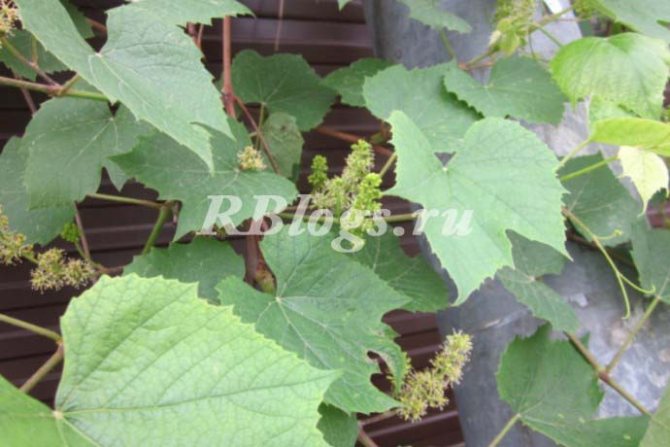

Grape ovaries
The pinching of the tops of fruiting shoots that have reached the last tier of the trellis is carried out several times as new ones grow. This allows you to speed up the ripening of bunches and vines.
Grasshopping - partial removal of lateral shoots that have grown from the buds of the current year, called stepchildren. The goal of this green surgery, performed two to three times over the summer, is to channel nutrients into the development of fruit buds.
Thinning
Thinning of leaves - removal of old leaves (up to 5 pieces) to ensure access of light and air to ripening bunches. A fully formed sheet works effectively for five to six weeks. For normal ripening of one bunch, seven leaves are enough. After July 15, it is necessary to thin out the leaves of the lower layer. It is advisable not to remove the leaves of the stepsons temporarily.
How to tie grapes
The grape plant, by its very nature, needs support. In this case, it grows and bears fruit better. There are many forms of supports. In the Moscow region, the usual vertical single-plane and inclined two-plane trellis are common.
A vertical single-plane trellis consists of pillars 1.5–2 m high, between which a wire with a diameter of about 3 mm is stretched in three or four rows (tiers). The bushes are placed on a trellis in one plane, the shoots, as they grow, are tied to a wire so that a solid green wall is created.
For vigorous varieties, it is recommended to arrange an inclined two-plane trellis, which differs from the usual vertical one by two planes inclined in opposite directions.
The shoots and sleeves of each bush are distributed and tied up on both planes of the trellis. The two-plane trellis allows more rational use of the area.
When arranging trellises, metal pipes, trunks of sawn trees, etc. are used. They are installed at a distance of 3-4 m from each other.
Transformation
This variety appeared relatively recently, but is already gaining its popularity in the practice of cultivation in the Moscow region. Shrubs are large and root well.
Ripening dates are early. The weight of the bunches of grapes varies between 700-1500 g. This is not a complete list of all the advantages that can be appreciated when choosing such a variety of open grapes for growing in the Moscow region.
The berries look very impressive in their light pink color and large size. The taste is in no way inferior - harmonious, sweet, with a slight sourness. The yield of the Transfiguration variety is very high - about 20 kg can be harvested from 1 plant. At the same time, peas are practically not observed.
Important! Considering this variety as an option for planting on your own site, one must take into account the not very high resistance to fungi, as well as susceptibility to wasps attacks. Frost resistance - up to minus 23C.
Shelter of grapes in the Moscow region for the winter
In the first decade of October, grapes planted in spring or summer are cut off: in plants with one shoot, five eyes are left, with two shoots - three eyes on each. They cover him for the winter:
- A film is spread on the entire width and length of the ridge on the ground (old pieces can be used) so that the insulating material does not damp.
- The cut shoots are bent to the ground. Under them and on top, spruce branches are laid along a branch and all this is pinned to the ground.
- Then comes a layer of insulating material 15–20 cm thick: dry leaves, reeds, sedges, raspberry, currant branches, etc.
- The top is covered with a waterproof material, preferably heavy (linoleum, roofing felt, sheets of fiberglass), so as not to be blown away by the wind. In the future, snow will warm the plants.
At the beginning of April, the insulation material is removed and removed until next year or transferred to compost heaps. The grape plant remains open until May. The shoots are still pinned to the ground, but the studs loosen a little.
At the beginning of May, arcs with a height of 70–80 cm are placed on the ridge and covered with foil. So the grapes grow until June 10, when the danger of possible late spring frosts has passed. Under the film, the shoots grow up to 70–100 cm. After the cover is removed, they are tied to a trellis.
SAVE USEFUL INFORMATION ON YOUR FAVORITE SOCIAL NETWORK PAGE:
Technical non-covering varieties
There are also technical grape varieties. We have also selected the best ones, which are designed for the Moscow region.
Namely:
- Rkatsiteli grapes with excellent aroma and taste and medium bunches, which at the time of ripening reach about 180 g.
- The variety that was created by breeders in Hungary is Furmint. This grape is used to make Tokyo wine.
- Pink traminer. This Austrian variety has been well known for many years. It can be called a mid-early species. Its round-shaped berries are of medium size, and the juice inside is colorless. These grapes are in demand due to their moderate disease resistance.
- Laid out on the banks of the Rhine - Riesling. These are grapes with small, but rather dense clusters and thin skin. Disease-resistant.
All varieties that have been listed above, as a rule, are not used in use in their original form. However, they are great for making compotes, wines or other drinks.
